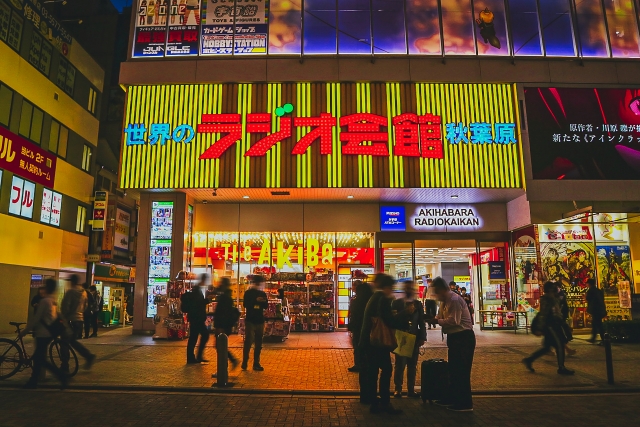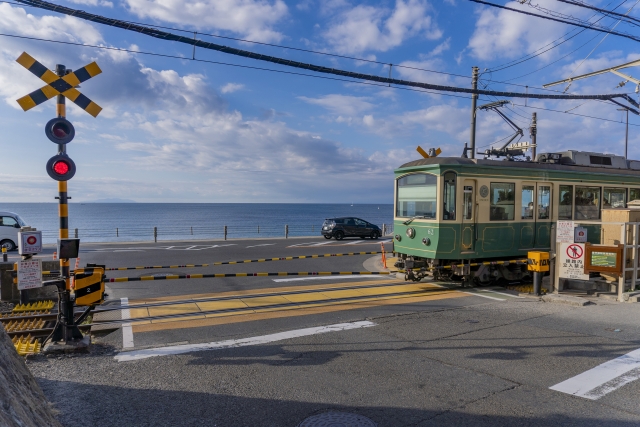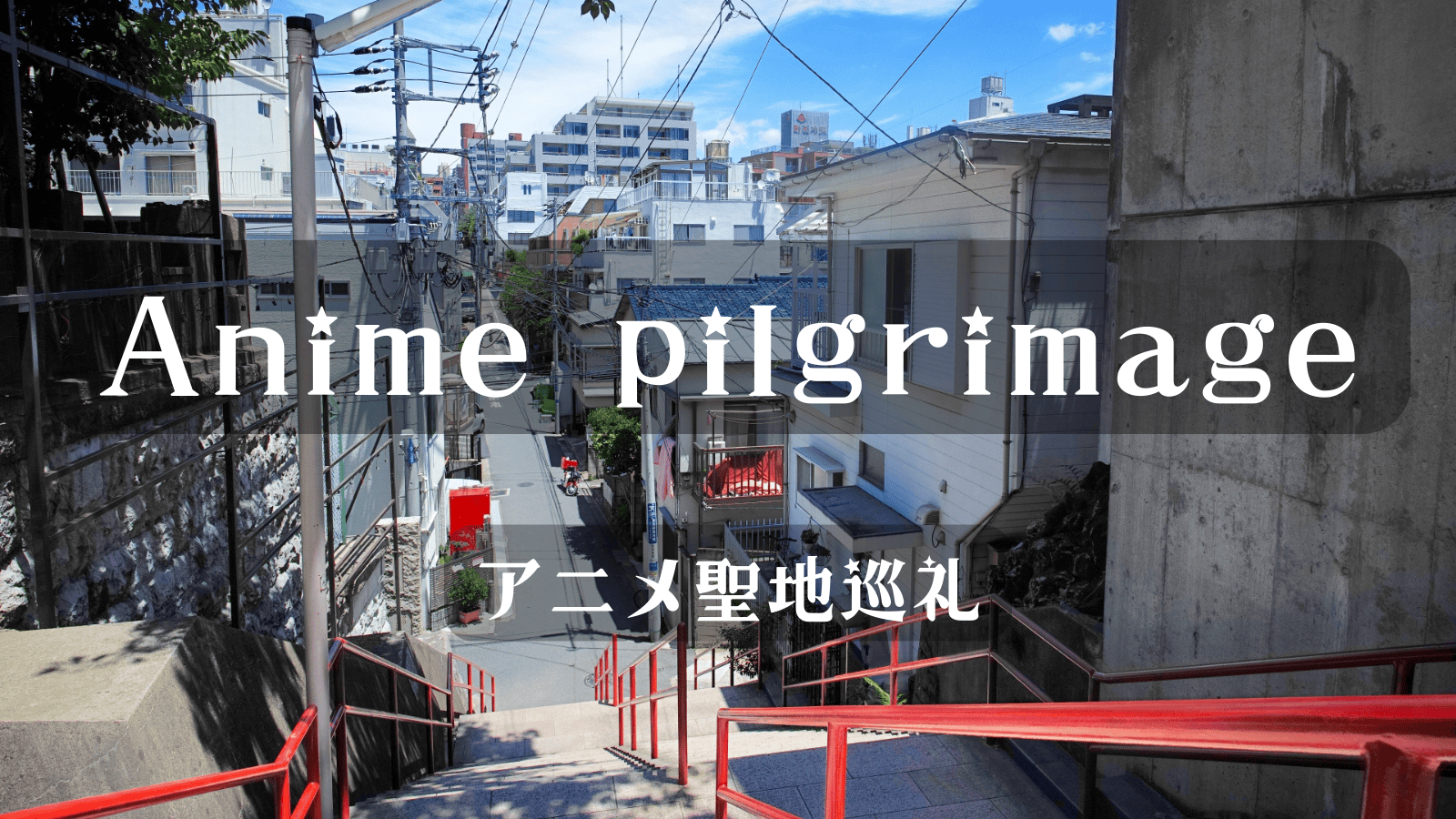The Global Influence of Japanese Anime
Japanese anime is now loved worldwide as entertainment, and its influence is immeasurable. With its precise animation, heart-stirring stories, and colorful characters, anime captivates many people by transcending language and cultural barriers. Anime events are held worldwide, and cosplay serves as an international exchange platform. Anime represents Japan’s pop culture and plays a critical role in increasing interest in Japan. For anime fans, “pilgrimage” is a special act that deepens their love for the works.
What is Pilgrimage?
“Pilgrimage” refers to visiting places that appear in anime, manga, games, and such, or the locations they are modeled after. Originally a religious term, in recent years, it has been widely used in the subculture realm.
The appeal of pilgrimage lies in the immersion in the world of the works, which is different from a mere sightseeing trip. Seeing the landscapes from anime unfold before your eyes and tracing the characters’ footsteps deepens understanding and affection for the works. Additionally, interacting with other fans and making new discoveries are the joys of pilgrimage.
Why Pilgrimage in Japan?
Japan is the birthplace of anime and manga culture, making it the “home” of pilgrimage. The country’s beautiful landscapes and diverse locations (urban, natural, historical sites) are appealing settings for anime. Moreover, there are many anime production companies and related facilities (museums, etc.) that can be enjoyed in conjunction with pilgrimage. The well-developed transportation infrastructure, safety, and culture of hospitality make Japan a reassuring destination for international tourists. Pilgrimage in Japan will be an unforgettable experience with special meaning for anime fans.

Preparing for a Pilgrimage
Information Gathering
- Official Information: Check trustworthy sources like official anime websites, tourism association sites, and local government sites. Look for event information, limited-edition goods, and collaboration projects.
- Fan Sites, Blogs, SNS: Refer to experienced peoples’ stories, detailed maps, photos, and points of caution. Utilize hashtag searches (e.g.,
#聖地巡礼,#[workname]聖地巡礼,#AnimePilgrimage). - Points of Caution: Pay attention to the freshness and credibility of the information. Use personal blogs as reference only.
Travel Planning
- Timing: Consider event dates and seasons (like cherry blossoms, autumn leaves). To avoid crowds, aim for weekdays or the off-season.
- Duration: If visiting multiple sites, ensure your schedule includes ample time. Consider travel times as well.
- Budget: Pre-calculate travel, accommodation, meal, and souvenir expenses.
- Accommodation: Book hotels, inns, or guesthouses near pilgrimage sites. There might be anime-themed rooms available.
- Transportation:
- Japan Rail Pass: A pass allowing unlimited travel on JR lines nationwide for international tourists.
- Others: Seishun 18 Kippu (for limited periods), highway buses, rental cars (international license needed), rental cycles, etc.
Essentials and Other Items
- Essentials: Smartphone (maps, translation, camera), mobile battery, cash, IC transit cards (Suica, PASMO, etc.), writing tools, basic medicines.
- Convenient Items: Anime goods, a foldable umbrella, comfortable shoes, hat, sunscreen (for summer), warm clothing (for winter).
- Other Items: Learning Japanese, translation app, Wi-Fi router, overseas travel insurance.
Enjoying and Mindful of Pilgrimage
Ways to Enjoy
- Photography: Recreate anime scenes, photograph with character goods, or capture the scenery of the pilgrimage sites. Sharing on social media is part of the fun (make use of hashtags).
- Tips: Shoot from the same angle, use goods, engage in cosplay (might need permission).
- Local Gourmet: Enjoy dishes featured in anime or limited-time gourmet foods at pilgrimage sites. Asking locals for recommendations is also good.
- Event Participation: Partake in regional events tied to anime or voice actors’ talk shows.
- Engage with Locals: Talk to residents or write messages in pilgrimage notebooks.
Points of Caution and Courtesy
- Consideration for Residents: Avoid making noise, do not litter, do not enter private properties.
- Photography: Do not photograph people without permission. Do not photograph in forbidden areas. Obtain permission for photography within stores or private properties.
- Cosplay: Avoid changing clothes in public places and overt exposure.
- Safety: Follow traffic rules, avoid walking alone at night, take heed of weather and attire in nature.
Pilgrimage Spots Introduction by Region
Kanto Region
Features: Centered around Tokyo, a wide variety of pilgrimage sites available. Offers a broad range of locations from urban to nature-filled places.
Access: The metropolitan area has developed transportation networks, making travel by train or bus convenient.
Pilgrimage Examples
Tokyo 23 Wards:
‘Love Live!’ (Akihabara)
- Highlights: Akihabara UDX (live scenes), AKIHABARA Gamers Main Store (store visited by μ’s), Shohei Bridge (practice area), Kanda Shrine (prayer site).
- Access: A short walk from the Electric Town exit of JR Akihabara Station (each facility).
- Surroundings: Anime shops, maid cafes, Electric Town.
- Notes: Photography within stores is permitted, get crowded on weekends.
‘STEINS;GATE’ (Akihabara)

- Highlights: Radio Kaikan (time machine), building modeled after Future Gadget Laboratory.
- Access: Close to the Electric Town exit of JR Akihabara Station (Radio Kaikan).
- Surroundings: Electric Town, anime shops.
- Notes: Entry to the building is restricted to authorized personnel.
‘Tokyo Ghoul’ (Ikebukuro, Ueno, etc.)
- Highlights: Cafe that modeled Anteiku (location non-disclosed, identified by fans), Ueno Park.
- Access: Around Ikebukuro Station, Ueno Station.
- Notes: Acts of nuisance at the modeled cafe are strictly prohibited.
‘Weathering With You’ (Shinjuku, Yoyogi)
- Highlights: Intersection behind Shinjuku Police Station, Weather Shrine (Koenji Hikawa Shrine), Yoyogi Kaikan (demolished), etc.
- Access: Various lines from Shinjuku Station, Koenji Station.
- Notes: Yoyogi Kaikan has been demolished.
‘Your Name.’ (Shinjuku, Yotsuya, etc.)

- Highlights: Suga Shrine (staircase), Shinjuku Gyoen.
- Access: Walk from JR Yotsuya Station (Suga Shrine), Shinjuku Gyoenmae Station on foot (Shinjuku Gyoen).
- Notes: Shinjuku Gyoen charges an admission fee.
Tokyo Suburbs:
‘My Neighbor Totoro’ (Tokorozawa City)
- Highlights: Totoro Forest (Sayama Hills, walking paths), Model for Shichikokuyama Hospital (Shinyamate Hospital, exterior only).
- Access: By bus from Seibu Line’s Kotesashi Station (Totoro Forest), by bus from Hachioji Station (Shinyamate Hospital).
- Notes: Entry to the hospital is not permitted, exterior only.
‘The Anthem of the Heart’ (Yokose Town, etc.)
- Highlights: Hitsujiyama Park (moss phlox), Old Chichibu Bridge.
- Access: Walk from Yokose Station on the Seibu Chichibu Line (Hitsujiyama Park), walk from Seibu Chichibu Station (Old Chichibu Bridge).
Kanagawa Prefecture:
‘Slam Dunk’ (Kamakura High School Front Station)

- Highlights: The railroad crossing from the anime’s opening.
- Access: Right at the Kamakura High School Front Station on Enoshima Electric Railway.
- Notes: Be careful not to obstruct traffic during photography.
‘TARI TARI’ (Enoshima)
- Highlights: Enoshima Benten Bridge, Enoshima Shrine.
- Access: Walk from Enoshima Station on the Enoshima Electric Railway.
‘Bungou Stray Dogs’ (Yokohama)
- Highlights: Yokohama Red Brick Warehouse, Yamashita Park, Yokohama Chinatown.
- Access: A walk from each station of the Minato Mirai Line.
Saitama Prefecture:
‘Anohana: The Flower We Saw That Day’ (Chichibu City)
- Highlights: Old Chichibubashi, Jorinji Temple, Chichibu Shrine.
- Access: Walk or take a bus from Seibu Railway Seibu Chichibu Station or Chichibu Railway Chichibu Station.
Kansai Region
Features: Kyoto, Osaka, Hyogo, with their historical city landscapes and unique urban scenery.
Access: Developed networks of shinkansen, trains, and buses.
Pilgrimage Examples
Kyoto Prefecture:
‘K-On!’ (Around Shugakuin Station)
- Highlights: Former Toyosato Elementary School Building Complex (modeled after Sakuragaoka High School, open for visits), Shugakuin Station.
- Access: Walk from Eizan Electric Railway Shugakuin Station. Walk from Ohmi Railway Toyosato Station to Toyosato Elementary School.
‘The Eccentric Family’ (Shimogamo Shrine, Demachi Masugata Shopping Street, etc.)
- Highlights: Shimogamo Shrine, Demachi Masugata Shopping Street.
- Access: Walk from Keihan Demachiyanagi Station (Shimogamo Shrine, Shopping Street).
‘Sound! Euphonium’ (Uji City)
- Highlights: Uji Bridge, Uji Shrine, Byodoin Temple.
- Access: Walk from JR Uji Station, Keihan Uji Station.
Hyogo Prefecture:
‘The Melancholy of Haruhi Suzumiya’ (Nishinomiya City)
- Highlights: Along Hankyu Koyo Line, North Nishinomiya High School (exterior), Cafe Dream (the cafe that served as a model).
- Access: Each station along the Hankyu Koyo Line.
- Notes: Entry to the high school is not allowed.
Osaka Prefecture:
‘Hypnosis Mic’ (America Mura, Dotonbori)
- Highlights: Triangle Park, Dotonbori Glico sign.
- Access: Walk from each subway line’s Namba Station, Shinsaibashi Station.
Chubu Region
Features: Rich in nature with oceans, mountains, and hot springs.
Access: Utilize shinkansen, trains, and buses.
Pilgrimage Examples
Shizuoka Prefecture:
‘Love Live! Sunshine!!’ (Numazu City Uchiura)
- Highlights: Mito Sea Bathing Beach, Nagaizaki Middle School (model), Yasudaya Inn (model).
- Access: By bus from JR Numazu Station (toward Uchiura).
Nagano Prefecture:
‘Summer Wars’ (Ueda City)

- Highlights: Ueda Castle Ruins Park, Ueda Electric Railway Bessho Line.
- Access: Walk from JR Ueda Station (Ueda Castle Ruins Park).
Aichi Prefecture:
‘Hypnosis Mic’ (Nagoya Sakae)
- Highlights: Oasis 21.
- Access: Sakae Station of Nagoya City Subway.
Hokkaido
Features: Expansive nature, unique culture.
Access: Use airports like New Chitose and Hakodate. Within Hokkaido, use JR, buses, or rental cars.
Pilgrimage Examples
Across Hokkaido:
‘Golden Kamuy’

- Highlights: Abashiri Prison Museum (modeled after Abashiri Prison), Hokkaido University (modeled after Sapporo Agricultural College), Otaru Canal, Hakodate Goryokaku, etc.
- Access: Use JR, buses for each area.
Hakodate City:
‘Love Live! Sunshine!!’
- Highlights: Hakodate Arena, Goryokaku Tower.
- Access: Use city tram, buses, etc.
Toyako Town:
‘Celestial Method’
- Highlights: Lake Toya, Toyako Onsen.
- Access: Bus from JR Toya Station to Toyako Onsen.
Haboro Town:
‘Kimi ni Todoke’
- Highlights: Model for Haboro High School (scenery), Haboro Shrine.
- Access: Take a high-speed bus from Sapporo to Haboro Town.
Summary
Pilgrimage serves as a special journey where one can experience the world of anime firsthand. It deepens affection for the works and provides new discoveries and emotions. Use this guide to carefully prepare, mind the manners, and enjoy a safe pilgrimage. Make your own incredible memories.
This blog will continuously provide information about pilgrimage. Updates on the latest information and events are planned. Please check regularly. We’re also sharing information on SNS (Twitter, Instagram, etc.). Please search with the hashtags “#聖地巡礼” “#AnimePilgrimage”.
Appendix
Q&A
- Q: Can pilgrimage be enjoyed alone?
A: Yes, it can be enjoyed alone. You can take your time to visit the sites at your own pace, and you can connect with other fans through pilgrimage notebooks. - Q: What is the recommended clothing for pilgrimage?
A: Comfortable walking shoes and easy-to-move-in clothing are recommended. In summer, bring a hat and sunscreen, and in winter, bring warm clothing. - Q: How much money does a pilgrimage cost?
A: Costs vary depending on personal plans, including travel, accommodation, meal, and souvenir expenses. Plan your budget beforehand. - Q: Is it okay if I can’t speak the language?
A: Knowing some simple Japanese is helpful. Utilize translation apps and gestures as well.

コメントを残す